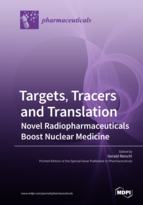Targets, Tracers and Translation – Novel Radiopharmaceuticals Boost Nuclear Medicine
A special issue of Pharmaceuticals (ISSN 1424-8247).
Deadline for manuscript submissions: closed (14 January 2019) | Viewed by 71894
Special Issue Editor
2. Cluster of Excellence iFIT (EXC 2180) "Image Guided and Functionally Instructed Tumor Therapies", University of Tübingen, Tübingen, Germany
Interests: radiopharmaceutical sciences; PET isotope production methods; PET tracer development; small molecules; antibodies and fragments; imaging of hypoxia/inflammation/infectious diseases; preclinical evaluation and translation into clinical application
Special Issues, Collections and Topics in MDPI journals
Special Issue Information
Dear Colleagues,
This is the 4th Special Issue in Pharmaceuticals within the last five years dealing with aspects of Radiopharmaceutical Sciences. It demonstrates a significant interest and increasing relevance to ameliorate Nuclear Medicine imaging with PET or SPECT, and also radiotherapeutical procedures.
Numerous targets and mechanisms have been identified and have been under investigation over the previous years, covering many fields of medical and clinical research. Oncology still is the most important area. In addition to tumor hypoxia, angiogenesis, apoptosis or inflammation, more recently, tumor senescence or targets like PSMA, chemokine receptors or tyrosine kinases are a focus of attention. In neuro imaging, especially imaging of neurodegenerative diseases, which previously focused on amyloid plaques, now Tau proteins, alpha-synuclein or TSPO as targets are being evaluated. Last but not least, in immunology imaging of inflammation or infectious diseases (bacterial or fungal) gain increasing interest.
In addition to the classical PET isotopes (18F, 11C, 13N, 15O) further nuclides are available (e.g., 68Ga, 64Cu, 89Zr, 44Sc). There are also new labeling techniques under development to aim for new highly specific tracers (radiopharmaceuticals) to investigate the targets mentioned.
In this context, the large variety of accessible animal and cell models for the preclinical evaluation of targets, mechanisms and tracers have to be highlighted.
Mandatory for successful developments in this multi-disciplinary environment are close collaborations among the researchers from medicine, biology, biochemistry, chemistry and pharmacy. Most of the members of the community of the radiopharmaceutical sciences work in a clinical periphery. All our basic research in radiochemistry and/or preclinical radiopharmaceutical development finds its justification and needs the perspective of a consequent translation of the results into clinical application in nuclear medicine. The statement “a mouse is not a man” is trivial and translation “from bench to bedside” must be the driving force. Regulatory requirements and especially GMP have become a challenge to be faced and handled, but nevertheless cannot be showstoppers.
Possible contributions of radiopharmaceutical sciences and nuclear medicine imaging to a personalized medicine have been shown in the past and even seem to be broader in the future. Imaging sciences today are regarded as an integral part of clinical research. With new therapies becoming more complex and specific, imaging together with, e.g., metabolomics procedures, histology and advanced data analysis is a most valuable tool in such multi-modal approaches, providing molecular and functional profiles for therapy planning and monitoring.
You are cordially invited to contribute original research, as well as review articles, to this Special Issue, “Targets, Tracers and Translation—Novel Radiopharmaceuticals Boost Nuclear Medicine”.
Areas of interest include, but are not limited to:
- New targets for imaging
- Tracer developments towards translation
- Multi-modal imaging
- Studies of tumor pathways
- Imaging for therapy monitoring
PD Dr. Gerald Reischl
Guest Editor
Manuscript Submission Information
Manuscripts should be submitted online at www.mdpi.com by registering and logging in to this website. Once you are registered, click here to go to the submission form. Manuscripts can be submitted until the deadline. All submissions that pass pre-check are peer-reviewed. Accepted papers will be published continuously in the journal (as soon as accepted) and will be listed together on the special issue website. Research articles, review articles as well as short communications are invited. For planned papers, a title and short abstract (about 100 words) can be sent to the Editorial Office for announcement on this website.
Submitted manuscripts should not have been published previously, nor be under consideration for publication elsewhere (except conference proceedings papers). All manuscripts are thoroughly refereed through a single-blind peer-review process. A guide for authors and other relevant information for submission of manuscripts is available on the Instructions for Authors page. Pharmaceuticals is an international peer-reviewed open access monthly journal published by MDPI.
Please visit the Instructions for Authors page before submitting a manuscript. The Article Processing Charge (APC) for publication in this open access journal is 2900 CHF (Swiss Francs). Submitted papers should be well formatted and use good English. Authors may use MDPI's English editing service prior to publication or during author revisions.
Keywords
- Tracer development
- PET and SPECT tracers
- Therapy monitoring
- Endoradiotherapy
- Translational approaches
- Nuclear medicine
Related Special Issues
- Emerging Theranostic Tracers in the Context of Radiopharmaceutical Drug Development in Pharmaceuticals (11 articles)
- Preparation of Radiopharmaceuticals and Their Use in Drug Development in Pharmaceuticals (3 articles)
- Radiopharmaceutical Chemistry between Imaging and Radioendotherapy in Pharmaceuticals (12 articles)
- Radiopharmaceuticals for Relapsed or Refractory Ovarian Cancers in Pharmaceuticals (1 article)
- Forward Thinking towards Theranostic (Radio)ligands Targeting the Tumor Microenvironment (TME) in Pharmaceuticals (6 articles)
- Next Generation of MRI Agents in Pharmaceuticals (9 articles)
- The Future Direction of Radiopharmaceutical Development for Cancer Theranostics in Pharmaceuticals (9 articles)
- Radiochemistry in Pharmaceuticals (2 articles)
- New Challenges in Radiochemistry in Pharmaceuticals (3 articles)







